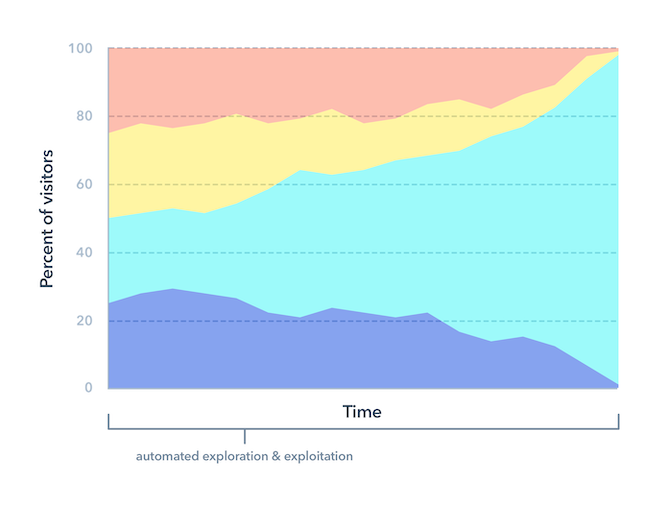Let me tell you a story about a man named Andrew.

Andrew managed a sales team for a startup in Dublin—we'll call it Grow Co. Andrew had worked hard to build a good relationship with Grow Co's marketing department. He and other leaders from both teams had sat down and worked rigorously to define the criteria for a qualified lead so that the sales team could trust the leads marketing provided them. The marketing team took that lead definition and programmed it to the lead scoring feature in their marketing automation platform, and they were off to the races.
Well, not quite.
As it turns out, the lead definition wasn't exactly right. This is pretty common: Most lead definitions require a few iterations, and they'll often change over time. Not long after the marketing team implemented the new lead scoring model, Andrew's team realized that some of the marketing-qualified leads they were receiving weren't any good. Some were located in countries that their company couldn't serve. Some were ostensibly a good fit for Grow Co's solutions, but they hadn't interacted enough with Grow Co's website to imply they had any interest. It was clear to Andrew and his team that their lead scoring model needed some adjustments.
So marketing and sales had another meeting, and they identified places where the model could be improved with a few minor changes. The marketing team agreed to update the lead scoring model accordingly.
But they didn't. Marketing continued to send over leads that clearly weren't meeting the new qualification standards. When Andrew asked about them, the marketing team admitted that the scoring model hadn't been updated but promised that it would be soon.
More time passed. Marketing still didn't updated the model. Sales began to lose faith in marketing's ability to qualify leads. Eventually, marketing qualified leads started getting ignored entirely.
Later, Andrew discovered that there was actually a reasonable explanation for this tragedy: Nobody on the marketing team had access to change the lead scoring model. The way their marketing automation platform was set up, only an administrator could change the model, and changing the model was such a difficult and tedious process that their system administrator simply never got around to doing it.
Although this is a sad and frustrating story, you can take some comfort in knowing that the marketing automation platform in this story wasn't HubSpot. HubSpot's lead scoring machinery is much more straightforward. In fact, by the time you get to the end of this blog post, you'll know everything there is to know about setting up lead scoring in your HubSpot account.
NOTE: Lead scoring is only available in Professional and Enterprise tiers of HubSpot.
The HubSpot Score Property
Lead scoring in HubSpot happens in a contact property called HubSpot Score. If you go to the Property Settings inside your HubSpot account, you'll see it listed there.
Access Your Properties in HubSpot
When you view the property, it'll look like an ordinary property at first, but if you scroll down, you'll discover a magical new world:
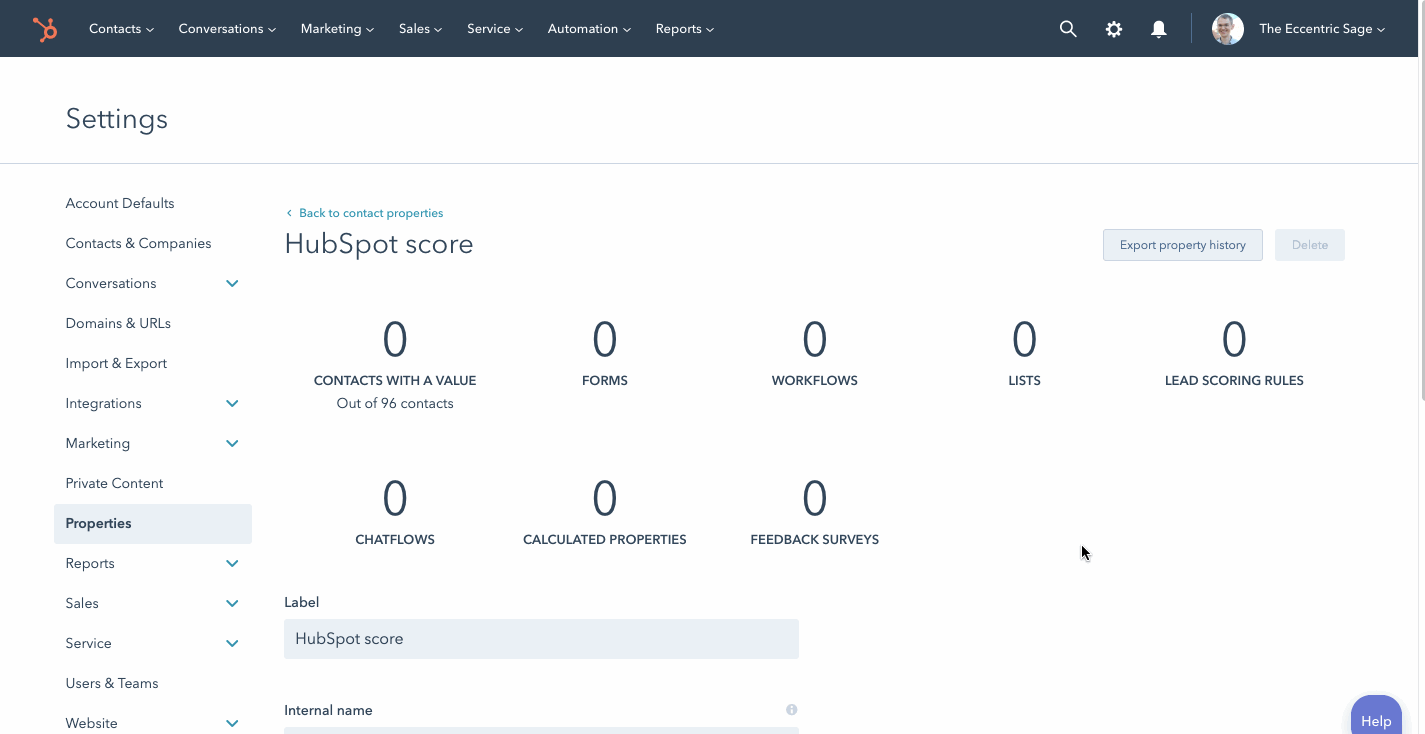
There at the bottom of the screen, you'll see two columns: Positive Attributes and Negative Attributes.
This is where the magic of lead scoring happens. Positive attributes are the characteristics that will increase a contact's lead score. Negative attributes are the opposite and make the lead's score go down.
These attributes can be pretty much anything that's tracked in HubSpot. If you click the "Add new set" button next to the positive or negative attributes, you'll see a list of options. Here's the full list, but I won't be offended if you decide to skim it—it's long! (If you've created a list in HubSpot, this might look familiar to you.)
- Contact properties - Using the same interface that you see when you filter your contacts, you can search for any contact property and set criteria for it.
- Company properties - Similar to the option for contact properties, this option is for setting criteria based on the properties of the contact's associated company (if they have one).
- Deal properties - Same, but for deals associated to the contact.
- Activity properties - Here you can set criteria based on activities on the contact record. Activities include meetings, conversations, tasks, notes, one-to-one emails, and phone calls that have been logged in HubSpot. You can see a more exhaustive list in this knowledge doc.
- Line item properties - If your team has a product library set up in HubSpot, you can change a contact's score based on the line items of the deals associated to their record. So you can add or subtract points based on the products they've expressed interest in or even the attributes of those products.
- List memberships - Add or subtract points if the contact is (or isn't) a member of a particular list.
- Form submission - Add or subtract points if the contact has (or hasn't) submitted a particular form. You can also take into account which page they submitted the form from, when they submitted it, or how many times they submitted it.
- Marketing emails - Add or subtract points based on the contact's interactions with a particular marketing email. Did it bounce? Did they click it? Did they unsubscribe? All these options and more are available to you, as well as the ability to look at a particular date range.
- Email subscription - Add or subtract points if a contact has opted into or out of a particular subscription (or if they haven't done either).
- Imports - Add or subtract points if a contact was (or wasn't) included in a particular import into HubSpot.
- Page view - Add or subtract points based on the pages a contact has (or hasn't) viewed on your website.
- Product properties - Add or subtract points based on the properties of the products associated to any of the contact's deals. You might be wondering how this is different from the "Line item properties" above. There's definite overlap here, but "Line items" includes things like the quantity, total value, and currency of the products listed in the deal, while "Product properties" looks at the products themselves.
- Events - Add or subtract points based on the events they have (or haven't) completed. You can also set your criteria based on when or how many times a contact has completed the event.
- Workflows - Add or subtract points based on a contact's relationship with a workflow. Here are the options for this one: contact is/isn't currently active in the workflow, contact has/hasn't completed the workflow, the contact has/hasn't been enrolled in the workflow, and the contact has/hasn't met the workflow's goal.
- Calls-to-action - Add or subtract points if a contact has (or hasn't) seen or clicked a certain CTA. Similar to events, you can narrow this criteria based on date range and number of times.
- Ads interactions - If you're using the HubSpot ads tool, you can add or subtract points based on interactions with Google, Facebook, and LinkedIn ads.
In addition to these, you might see additional options if you've integrated other apps with HubSpot. Zoom, SurveyMonkey, and other integrations all add options for lead scoring.
Now that you've gotten a glimpse into all the criteria you can use to score your leads, let's take a look at a couple of examples: one for positive attributes, one for negative attributes.
Positive Attributes
Let's say your product is targeted at VP-level contacts. You could add a positive attribute for certain job titles. For this example, let's add five points to someone's lead score if they have a title that indicates they're a vice president.
That would look like this:
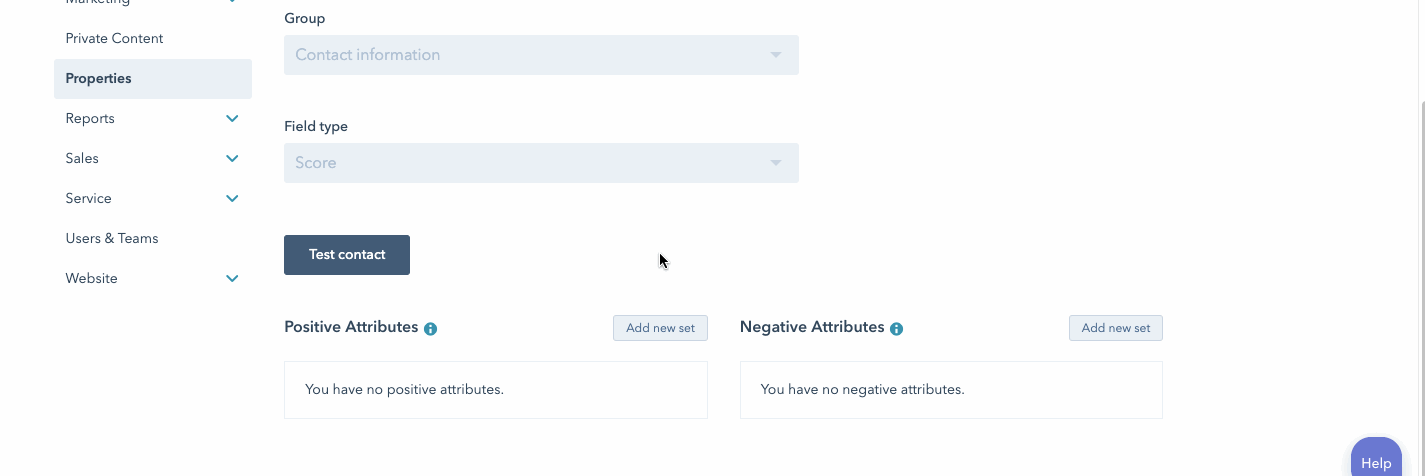
If you did that in your portal, then anytime a contact had a job title that included "vp" or "vice," five points would get added to their lead score.
Negative Attributes
In Andrew's story, part of the problem with Grow Co's lead scoring was that it qualified leads who were in countries that Andrew's team couldn't serve. If Grow Co was setting up lead scoring in HubSpot, they would want to subtract points from contacts based in those countries.
That might look like this:
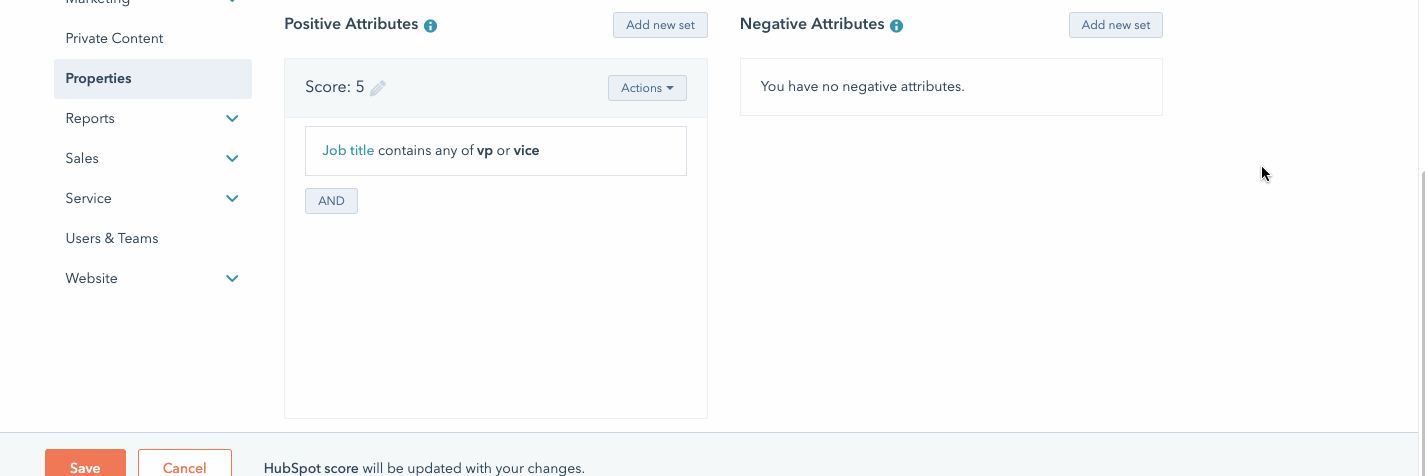
Now, Andrew and his team never have to worry about trying to contact people in Lilliput. What a relief.
"AND" vs "OR"
As you define the positive and negative attributes for your lead scoring model, you'll need to add multiple sets of attributes. Sometimes, you'll want multiple attributes to contribute to a single point value, and sometimes you'll want each attribute to award its own points. Let's look at the difference between these two.
First, having multiple attributes contribute to a single score. For example, if you wanted to award five points to vice presidents of companies in certain industries, you could click the "AND" button to add industry to your positive attribute.
That would look like this:
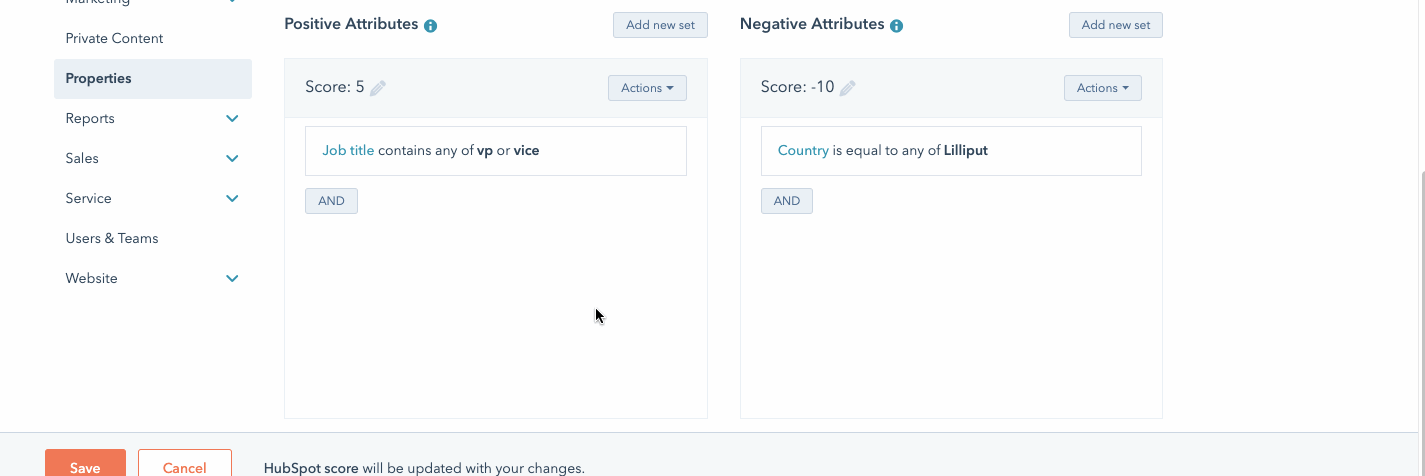
Alternatively, if you would like to award points separately for industry and job title, you would click the "Add new set" button instead of the "AND" button.
That would look like this:

Awarding Points Multiple Times
It's important to note that the score values you set will only be awarded once per contact. For example, if you award two points for clicking a particular CTA, those points will only be awarded the first time the person clicks that CTA. If you want to award additional points for subsequent clicks, you'll need to create an additional score and set it for when someone clicks the CTA a certain number of times.
In instances like this, it's good to set thresholds: x points for the first click, x points for anyone who's clicked it five times, x points for anyone who's clicked it 10 times. It's important to remember, though, that these points are additive. So if someone gets one point for clicking the CTA the first time and five more points when they click it the fifth time, they'll end up with a total of six points for CTA clicks.
Editing Lead Score
Remember how Grow Co struggled to update their lead status? In HubSpot, you can edit your lead score at any time.
To change the points awarded by a set of attributes, click the pencil next to the score.
 To change the criteria for a specific attribute, click on its name.
To change the criteria for a specific attribute, click on its name.
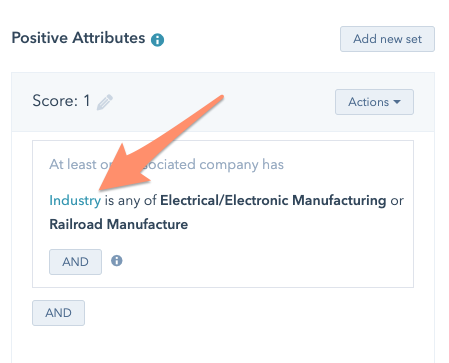
Finally, to delete a set of attributes altogether, click the "Actions" dropdown menu and select "Delete."
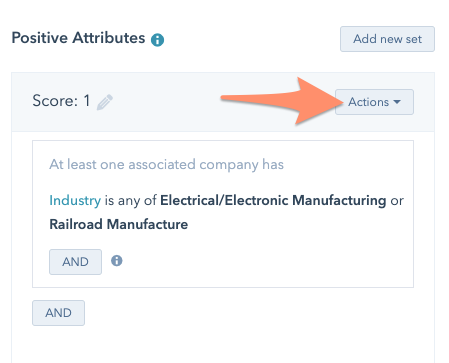
And now you know how to set up lead scoring in HubSpot. Go forth and build good relations between marketing and sales.
Want to connect with others on HubSpot tips, tricks, and updates? Head over to the HubSpot Community to join a conversation or start one of your own.










